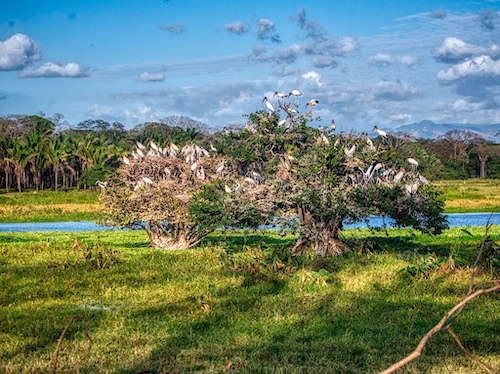
While we were visiting the Hacienda Solimar, with my Tropical Birding tour, we went one afternoon to a nearby rookery. It was located on both sides of what appeared to be an irrigation canal and the marshy environment seemed to be a magnet for all sorts of birds, but especially Wood Storks and Cattle Egrets. During the dry season water is scarce in other parts of the country. Due to this, many birds flock to Palo Verde National Park and its river basin. The park protects one of the most endangered ecosystems. It is one of the last remaining tropical dry rainforests that once covered most of Central America. Tropical dry rainforests now exist in less than 0.1% of their original size and are considered to be the most endangered ecosystems in the tropics. Palo Verde National Park was declared a Wildlife Refuge during the 1970s because of over 60 different species of birds used the Laguna, or wetland, as a migratory stop. There were once 35,000 black bellied whistling ducks, 25,000 blue winged teal, and several hundred migrating ducks during the dry season. Although Hacienda Solimar is not in the park, it benefits from the conservation efforts occurring there. The dry season concentrates the watering locations for the birds and while just about any time is good for birdwatching, the dry season makes the areas more accessible. A good example is this Wood Stork rookery we found on the grounds of the ranch in February with a large variety of birds.
The Rookery
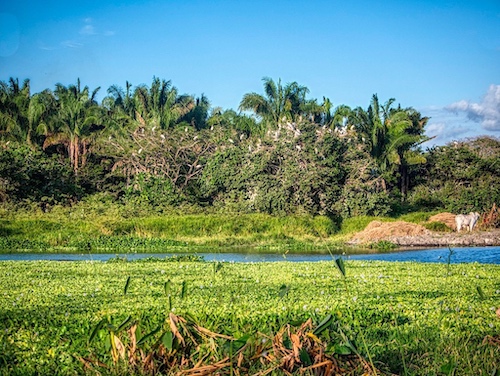
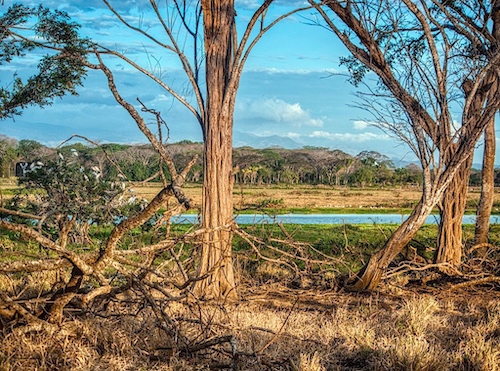
Most of the birds in this rookery were Wood Storks. The Wood Stork (Mycteria americana) is a subtropical and tropical species which breeds in much of South America, Central America and the Caribbean. The wood stork is the only stork that breeds in North America. A resident breeder in lowland wetlands with trees, the wood stork builds a large 3 foot (1 m) stick nest in a tree. In freshwater habitats, it prefers to nest in trees that are larger in diameter. It nests colonially, with up to 25 nests in one tree. The height of these nests is variable, with some nests located in mangrove trees being at heights of 8–21 feet (2.5–6.5 m). Breeding is initiated by a drop in the water level combined with an increased density of fish (with the former likely triggering the latter). This is because a decrease in the water level and an increased density of fish allows for an adequate amount of food for the nestlings. This can occur anytime between November and August. After it starts, breeding takes about four months to complete.
Wood Storks
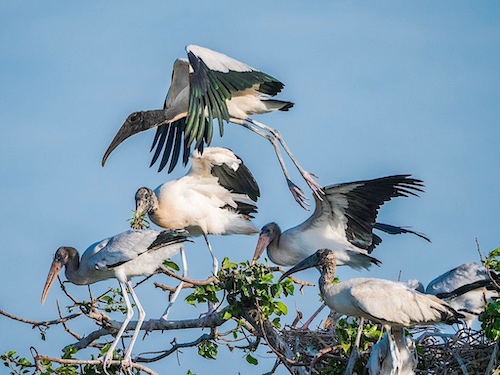
The adult wood stork is a large bird which stands 33–45 inches (83 to 115 cm) tall with a wingspan of 55–71 inches (140 to 180 cm). The male typically weighs 6.0 lb (2.7 kg) and the female weighs 5.3 lb (2.42 kg). The head and neck of the adult are bare, and the scaly skin is a dark grey. The black downward-curved bill is long and very wide at the base. The plumage is mostly white, with the primaries, secondaries, and tail being black and having a greenish and purplish iridescence. The legs and feet are dark, and the flesh-colored toes are pink during the breeding season. The sexes are similar.
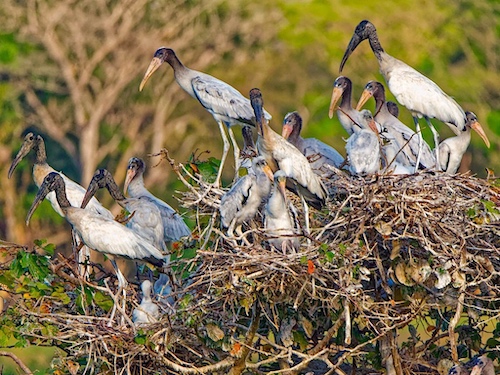
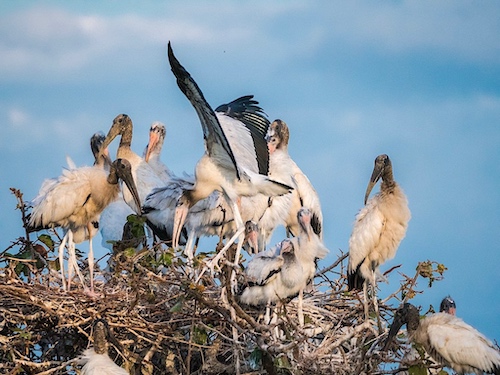
Newly hatched chicks have a sparse coat of grey down (protoptiles) that is replaced by a dense, wooly, and white down (mesoptiles) in about 10 days. Chicks grow fast, being about half the height of adults in three to four weeks. By the sixth and seventh weeks, the plumage on the head and neck turns smokey grey. When fledged, they resemble the adult, differing only in that they have a feathered head and a yellow bill.
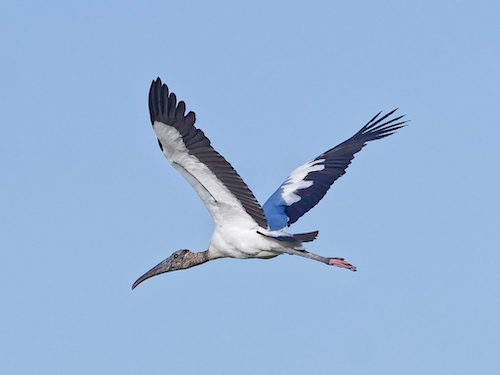
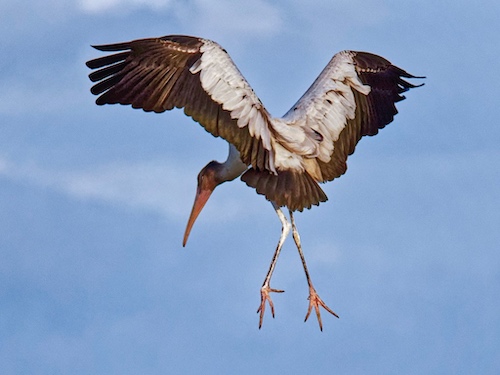
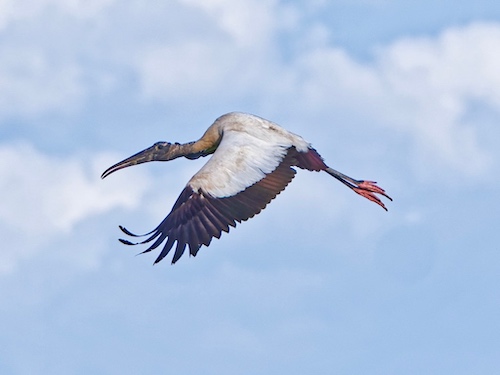
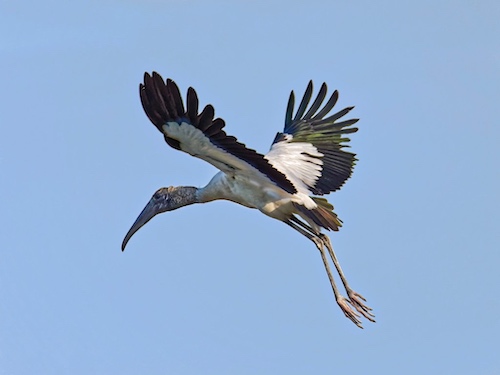
Since there were so many wood storks, it was a perfect opportunity to practice my birds in flight photography. One thing I noticed is that despite the many naysayers, the Panasonic G9 contrast detection, depth from defocus (DFD), worked quite well with complex backgrounds like trees.
Roseate Spoonbill
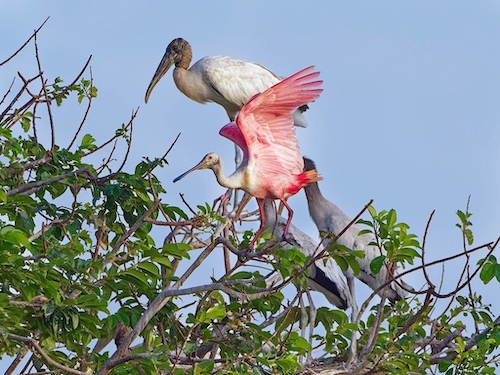
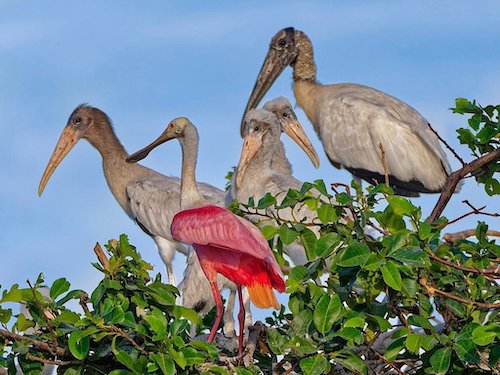
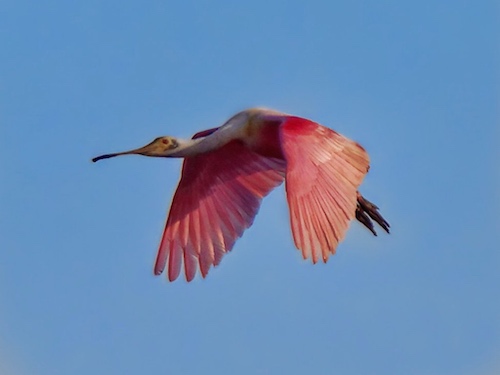
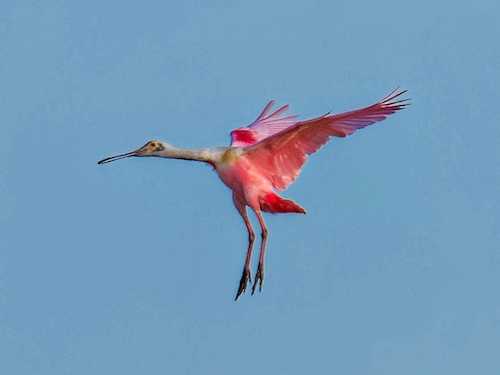
Roseate Spoonbills (Platalea ajaja) get their pink coloration from the foods they eat, like flamingos. Crustaceans and other aquatic invertebrates contain pigments called carotenoids that help turn their feathers pink. The colors can range from pale pink to bright magenta, depending on age, whether breeding or not, and location. Unlike herons, spoonbills fly with their necks outstretched. It forages by wading in shallow muddy water, sweeping bill from side to side with mandibles slightly open, detecting prey by feel. Adults have a bare greenish head (“golden buff” when breeding) and a white neck, back and breast (with a tuft of pink feathers in the center when breeding), and are otherwise a deep pink. Spoonbills can share a roosting and nesting colony with egrets, herons, ibises and wood storks. They fly to and from feeding and roosting areas with slow and deep wingbeats with their legs and neck fully extended.
Jabiru
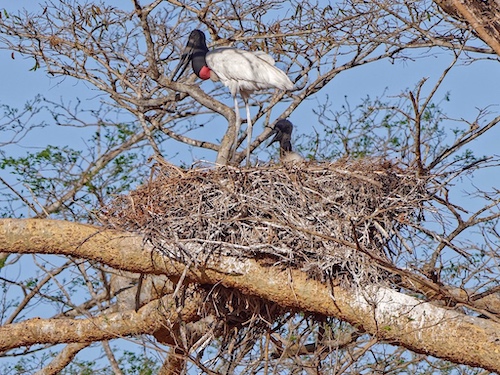
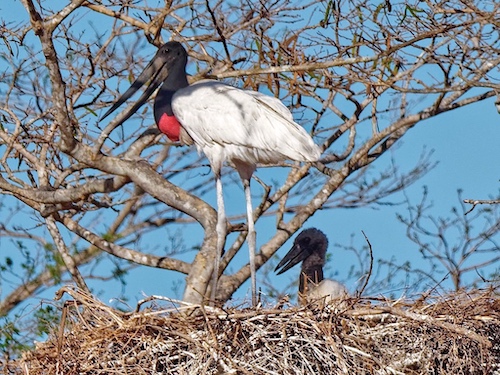
As we were walking into the rookery, across a long field, we saw a Jabiru and a chick in a huge nest. The Jabiru (Jabiru mycteria) is the tallest flying bird found in South America and Central America. For the continent, it also has the second largest wingspan, after the Andean condor (that is, excluding the great albatross occasionally found off the coast of southern South America). The adult jabiru is 47–55 inches (120–140 cm) tall, 7.5–9.2 feet (2.3–2.8 m) across the wings, and can weigh 9.5–19.8 pounds (4.3–9 kg). The nest of sticks is built by both parents around August–September (in the Southern Hemisphere) on tall trees, and enlarged at each succeeding season growing to over 10 feet (3 m) in diameter. Nests are often deeper than they are wide, they can be up to 6 feet (2 m) deep. Half a dozen nests may be built in close proximity, sometimes among nests of herons, wood storks and other birds. I only saw this single Jabiru nest.
Cattle Egrets
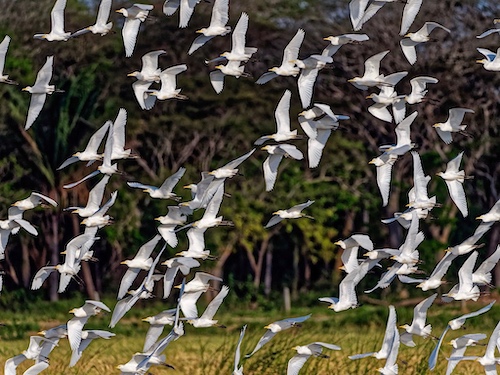
The Cattle Egret (Bubulcus ibis) has undergone one of the most rapid and wide-reaching natural expansions of any bird species. It was originally native to parts of southern Spain and Portugal, tropical and subtropical Africa, and humid tropical and subtropical Asia. At the end of the 19th century, it began expanding its range into southern Africa, first breeding in the Cape Province in 1908. Cattle egrets were first sighted in the Americas on the boundary of Guiana and Suriname in 1877, having apparently flown across the Atlantic Ocean. Today it is found across the world. The massive and rapid expansion of the cattle egret’s range is due to its relationship with humans and their domesticated animals. Originally adapted to a commensal relationship with large grazing and browsing animals, it was easily able to switch to domesticated cattle and horses. As the keeping of livestock spread throughout the world, the cattle egret was able to occupy otherwise empty niches. It should not come as a surprise that they would be present on a large cattle ranch like the Hacienda Solimar. There were several hundred on the opposite shore that would periodically rise up in great white clouds.
Tiger Herons
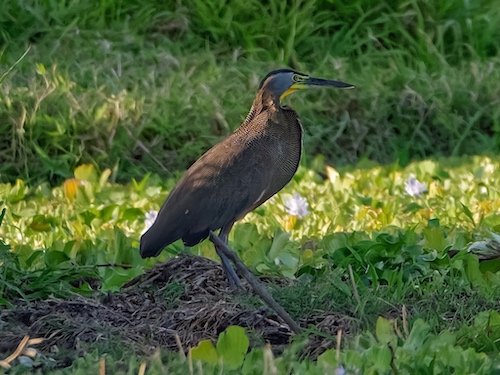
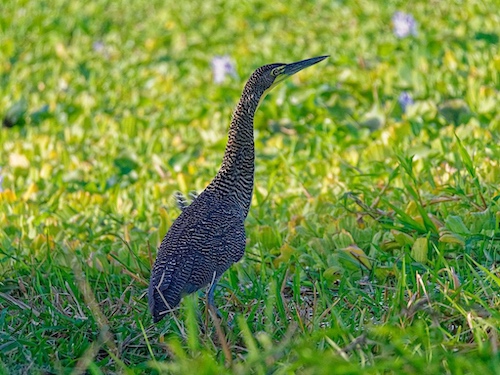
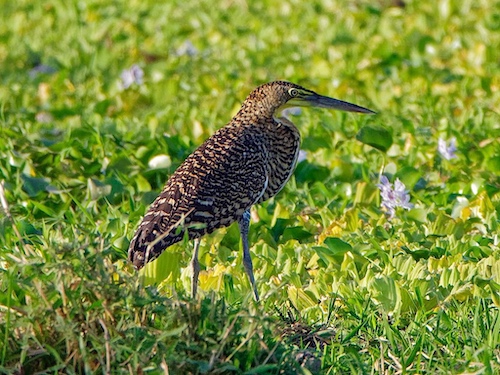
Tigrisoma is a genus of heron established by William John Swainson in 1827. The name Tigrisoma is a combination of two Greek words: tigris, meaning “tiger” and somā, meaning “body”. This genus contains three Tiger Herons that look pretty similar as juveniles although they appear quite different as adults. The only way to make some sense of identifying them is by observing the place and circumstances of the observation. The first juvenile looks a lot like a Fasciated Tiger Heron (Tigrisoma fasciatum). However, this Tiger Heron is found above 2400 feet, is almost always alone and is found in fast moving streams. In addition in Costa Rica and Panama, the northern limit of its range, it is found on the Caribbean slopes in the west of the country. The second juvenile looks a lot like the juvenile Rufescent Tiger Heron (Tigrisoma lineatum) with its rusty-buff coloration, coarsely barred with black. The Rufescent Tiger-Heron generally is the least-frequently encountered of the three species of Tigrisoma, and is considered uncommon to rare through much of its range. Found in lowlands from southern Mexico south to northern Argentina, adult Rufescent Tiger-Herons are easily separated from the other species of tiger-heron by their rich rufous upperparts, especially the head and neck. Two things that might help in juveniles are the shorter and stouter bill and the range in Costa Rica on the Caribbean side. Since these three were part of a group on the Pacific side at sea level, it is likely but not certain, that all are Bare-Throated Tiger Herons.
Laughing Falcon
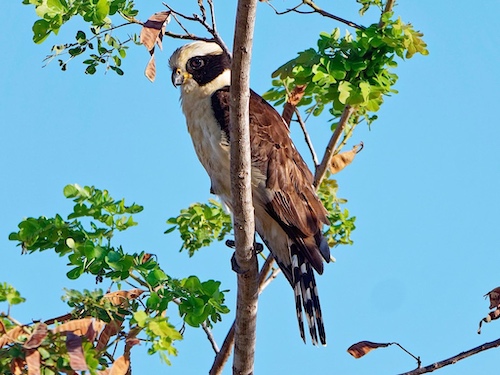
The Laughing Falcon (Herpetotheres cachinnans), also called the snake hawk, is found in a variety of forested habitats from northern Mexico south to Paraguay. The laughing falcon is 18 to 22 inches (46 to 56 cm) long and has a wingspan of 31 to 37 inches (79 to 94 cm). It can be found in cerrado, dry forests, gallery forest and lowland rainforest, but is most common along forest edges. The Laughing Falcon feeds primarily on terrestrial or arboreal snakes. Its preys can be large and venomous snakes, and include several kinds of snakes. It also hunts lizards and rodents in cultivated areas, and sometimes fish. The namesake call is a long series of separate, rather human-like cries, each one often rising sharply in pitch in the middle and sometimes falling sharply at the very end, changing from a “joyful” to a “sad” sound, and rendered as “ha-ha-ha har-her-her” or “haww harr herrer”. The series may be introduced by faster “hahahahahaha” calls suggestive of maniacal laughter, particularly when the bird is startled. The laughing falcon has another call, typically given at dusk. This two-note call is preceded by a series of “gwa” notes given every half-second or so. They become more emphatic and after some time change to a sequence of the “gwa co” call proper, with the first syllable higher in pitch than the second, but not differing in emphasis or volume. The “gwa co” call may be repeated 50 times or more.
Smaller Birds
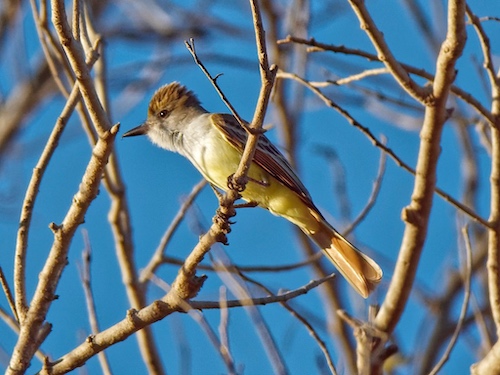
The Brown-Crested Flycatcher (Myiarchus tyrannulus) is best separated from other confusingly similar Myiarchus species by its call, a rough loud “come HERE, come HERE” or “whit-will-do, whit-will-do”. I believe I heard this call although it was pretty noisy there. The other birds most likely to be considered are the Great Crested Flycatcher (Myiarchus crinitus) and the Panama Flycatcher (Myiarchus panamensis). The Great Crested Flycatchers are common, larger, brightly colored flycatchers, but they spend much of their day very high in the leafy canopy of deciduous woods. Their range does extend to Costa Rica and beyond. The Panama Flycatcher is found in Colombia, Costa Rica, Panama, and Venezuela. It is more drab with dull brown wings without warm rufous colors. Thus I am pretty sure about this identification although Myiarchus are always tricky.
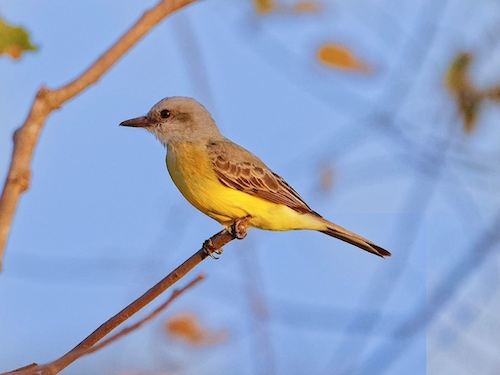
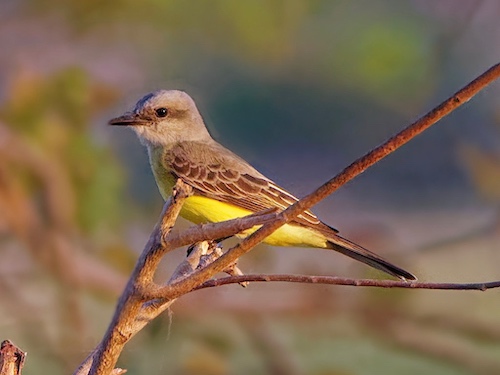
The Tropical Kingbird (Tyrannus melancholicus) is a large tyrant flycatcher. This bird breeds from southern Arizona and the lower Rio Grande Valley of Texas in the United States through Central America, South America as far as south as central Argentina and western Peru, and on Trinidad and Tobago. Birds from the northernmost and southern breeding areas migrate to warmer parts of the range after breeding. An adult tropical kingbird is 8.7 inches (22 cm) long and weighs 1.4 oz (39 g). The head is pale gray, with a darker eye mask, an orange crown stripe, and a heavy gray bill. The back is grayish-green, and the wing and forked tail are brown. The throat is pale gray, becoming olive on the breast, with the rest of the underparts being yellow.Tropical kingbirds like to observe their surroundings from a prominent open perch, usually high in a tree, undertaking long sally flights to acrobatically catch insects in mid-air (hawking), sometimes hovering to pick food off vegetation (gleaning).
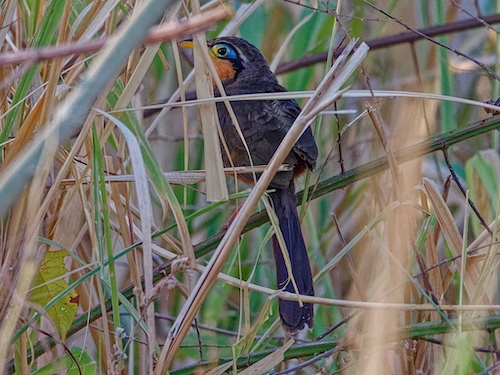
The Lesser Ground-Cuckoo (Morococcyx erythropygus) is endemic to the Pacific slope of Middle America. It is found in arid lowland scrub and tropical deciduous forest below 1800 m from western Mexico south to northwestern Costa Rica. The upperparts are mostly dull brown, with rufous tips to the feathers of the rump and uppertail coverts, and a green sheen to the wing. Lesser Ground-Cuckoo has an ornate pattern on the face, with a black mask on the sides of the head, enclosing a bright yellow orbital ring, broader before the eye, and bright blue bare skin behind the eye. There also is a short white postocular stripe, which can be indistinct. The underparts of Lesser Ground-Cuckoo are cinnamon/orange. Sexes are similar, but the juvenile is duller. It is furtive and rarely seen, but its loud song carries well and sounds like a referee’s whistle being blown faster and then slower. It inhabits brushy dry woodland in tropical lowlands, where most of the time it walks stealthily on the ground.
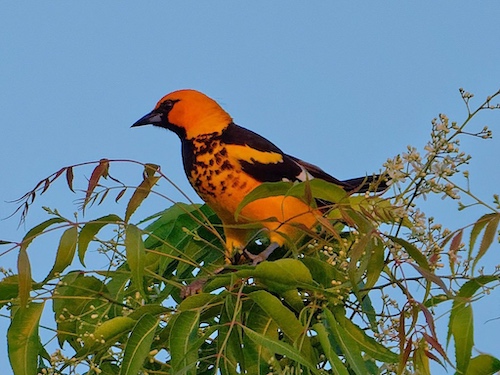
The Spot-Breasted Oriole (Icterus pectoralis) is native to Costa Rica, El Salvador, Guatemala, Honduras, Mexico, and Nicaragua. It is a mid-sized songbird and generally typical oriole. It is bright orange overall with a black bib and black spotting on the sides of the breast. The sexes are similar looking generally but females and juveniles are olive-green on the back and tail, dusky wings, and little or no black on face, throat, or breast. Adults measure 8.3–9.4 inches (21–24 cm) in length. Its natural habitats are subtropical or tropical dry forests, subtropical or tropical moist lowland forests, and heavily degraded former forest. The spot-breasted oriole ranges only on the Pacific side of Central America.
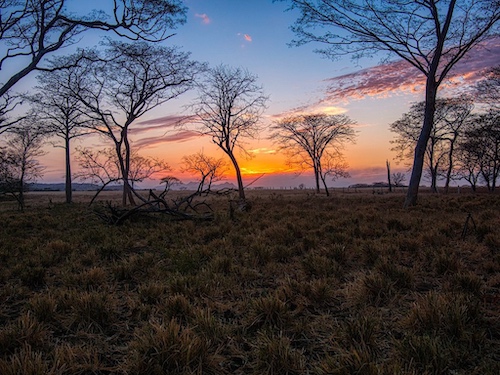
As always, I hope you enjoyed the post, I felt this was a productive and beautiful environment for bird photography.

